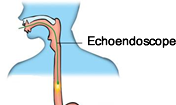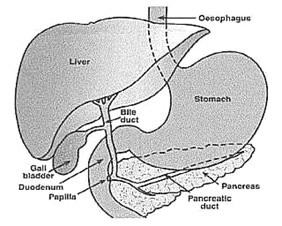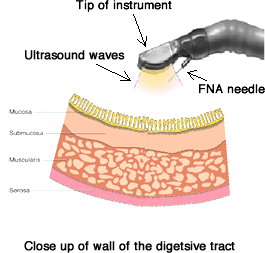Endoscopic Ultrasound (EUS)
What is an Endoscopic Ultrasound (EUS)?
 An endoscopic ultrasound (EUS) allows your doctor to examine the lining and the walls of your oesophagus, stomach and duodenum. EUS is also used to study internal organs that lie next to the gastrointestinal tract, such as the gall bladder and pancreas. We offer endoscopic ultrasound at our Brisbane clinics.
An endoscopic ultrasound (EUS) allows your doctor to examine the lining and the walls of your oesophagus, stomach and duodenum. EUS is also used to study internal organs that lie next to the gastrointestinal tract, such as the gall bladder and pancreas. We offer endoscopic ultrasound at our Brisbane clinics.
A thin, flexible tube (echoendoscope) will be passed through your mouth to the area to be examined. An ultrasound transducer is present at the tip of the instrument. The ultrasound component will then produce ultrasound waves that
create detailed visual images of the area to be studied.
Why is an Endoscopic Ultrasound (EUS) done?
An endoscopic ultrasound (EUS) is used to evaluate an abnormality, such as a growth, that was detected at a prior endoscopy or by x-ray or scan. EUS provides a detailed picture of the growth, which can help your doctor determine its nature and decide upon the best treatment. If the growth arises from the wall of the digestive tract, EUS can help determine which layer in the wall the growth arises from. In some circumstances, a thin needle can be passed through the endoscope into the growth to suck up (aspirate) cells. This is known as Fine Needle Aspiration (FNA).
In addition, an endoscopic ultrasound (EUS) can be used to diagnose diseases of the pancreas, bile duct and gallbladder when other tests are inconclusive.


Why is an Endoscopic Ultrasound (EUS) used for patients with cancer?
An endoscopic ultrasound (EUS) helps determine the extent of certain cancers of the digestive and respiratory systems. EUS allows your doctor to accurately assess the cancer’s depth and whether it has spread to adjacent lymph glands or nearby vital structures such as major blood vessels. In some patients, EUS can be used to obtain tissue samples to help your doctor determine the proper treatment (FNA).
How should I prepare for an Endoscopic Ultrasound (EUS)?
For an endoscopic ultrasound (EUS) of the upper gastrointestinal tract, you should have nothing to eat or drink, not even water, usually six hours before the examination. Your doctor will tell you when to start this fasting.
What about my current medications or allergies?
Please advise Queensland Gastroenterology of all medications prior to your procedure.
What can I expect during an Endoscopic Ultrasound (EUS)?
You will receive twilight sedation. You will most likely begin by lying on your left side. After you receive sedatives, the procedure will commence. The instrument does not interfere with your ability to breathe. The actual examination generally takes between 30 and 60 minutes.
What happens after an Endoscopic Ultrasound (EUS)?
If you received sedatives, you will be monitored in the recovery area until most of the sedative medication’s effects have worn off. Your throat might be sore. You might feel bloated because of the air and water that were introduced during the examination. You’ll be able to eat after you leave the procedure area, unless you’re instructed otherwise.
Your doctor will inform you of the results of the procedure that day, but the results of some tests will take longer. Expect to be in the hospital for a total of 3 to 4 hours.

